| ||
 Taishu (taishu uma) or Tsushima (Tsushima uma) are small rare
Japanese horses from Tsushima Island in the Korea Strait, in Nagasaki
Prefecture, Japan.
Taishu (taishu uma) or Tsushima (Tsushima uma) are small rare
Japanese horses from Tsushima Island in the Korea Strait, in Nagasaki
Prefecture, Japan.They are an ancient breed, believed to date back to the eighth century. In 1920, there were more than 4000 of them, but only about 65 remain today. Due to their gentle nature and strong willingness to obey, Tiasho are often ridden by farmers’ wives and children. Nevertheless, they are also known for endurance and ability to survive on little food and in severe weather, and may even be used for light draft. Source: Japanese Horse Breeds ( www.lingualift.com/blog/japanese-horse-breed ... | ||
 | ||
| ||
 Tarpans are a now extinct wild horse from Russia. The last
two on the planet died within a decade of each other in the late 19th century.
Tarpans are a now extinct wild horse from Russia. The last
two on the planet died within a decade of each other in the late 19th century.
Essentially the Tarpan is one of the few wild equines that existed during prehistoric times and they are thought to be the ancestors of most modern breeds that come from the Russian Steppes. Originally they were found throughout Eastern Europe and western Russia and became the foundation stock for many civilizations along the eastern Mediterranean. For thousands of years they were a mainstay in many cultures and their blood is a part of a wide variety of modern breeds. They were hunted to extinction in a similar manner as the modern Mustang is today in the western US. ... | ||
 | ||
| ||
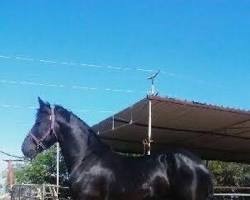 From the rugged mountains of Sudan hails the Tawleed horse, a breed celebrated for its low-maintenance nature, impressive stamina, and riding capabilities. Bred in the Khartoum region by crossing local and imported bloodlines, these hardy animals have become a vital companion for the people of Sudan.
From the rugged mountains of Sudan hails the Tawleed horse, a breed celebrated for its low-maintenance nature, impressive stamina, and riding capabilities. Bred in the Khartoum region by crossing local and imported bloodlines, these hardy animals have become a vital companion for the people of Sudan.
Despite their unassuming demeanor, Tawleed horses are incredibly strong and sturdy. They require minimal care, allowing them to thrive even in challenging environments. This easy-going nature is coupled with exceptional endurance, making them dependable partners for traversing the mountainous terrain they call home. But their value extends beyond mere practicality. Tawleed horses excel as riding mounts, offering smooth gai ... | ||
 | ||
| ||
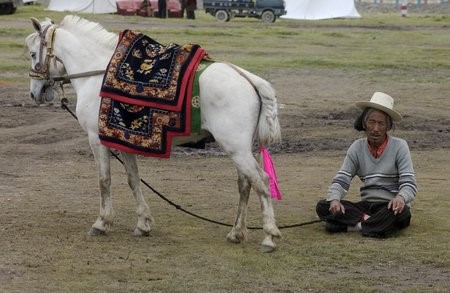 Tebetan Ponies are descended from ancient stock, likely
partly from Mongolian Ponies and Chinese pony breeds, although they have been
bred pure for years. They are are well-regarded by the local people, and they
have been traditionally kept by both wealthy Tibetans and farmers alike, as
well as by the Dalai Lama. They were sent as gifts to Chinese Emperors, especially
during the Ming and Tang dynasties.
Tebetan Ponies are descended from ancient stock, likely
partly from Mongolian Ponies and Chinese pony breeds, although they have been
bred pure for years. They are are well-regarded by the local people, and they
have been traditionally kept by both wealthy Tibetans and farmers alike, as
well as by the Dalai Lama. They were sent as gifts to Chinese Emperors, especially
during the Ming and Tang dynasties.
As small as they are the ponies are known for their incredible strength and endurance, for sure-footedness and resilience. Their heads usually have a pronounced jaw line, straight profile, and small ears and eyes. The neck is a muscular and a short, the chest is deep, the shoulder is straight. The ponies have powerful hi ... | ||
 | ||
| ||
 A light horse breed founded in middle Tennessee, the Tennessee
Walking Horse is a composition of Narragansett and Canadian Pacer, Standardbred,
Thoroughbred, Morgan, and American Saddlebred stock. Originally bred as a utility
horse, this breed is an ideal mount for riders of all ages and levels of experience.
The breed easily adapts to English or Western gear, and its calm, docile temperament
combined with naturally smooth and easy gaits insure the popularity of the Tennessee
Walking Horse as the "world''s greatest show, trail, and pleasure horse."
A light horse breed founded in middle Tennessee, the Tennessee
Walking Horse is a composition of Narragansett and Canadian Pacer, Standardbred,
Thoroughbred, Morgan, and American Saddlebred stock. Originally bred as a utility
horse, this breed is an ideal mount for riders of all ages and levels of experience.
The breed easily adapts to English or Western gear, and its calm, docile temperament
combined with naturally smooth and easy gaits insure the popularity of the Tennessee
Walking Horse as the "world''s greatest show, trail, and pleasure horse."
Owning a Tennessee Walking Horse is affordable, with a price range for every person''s pocketbook. Considering the breed''s easy ride, the companionship, its dependability ... | ||
 | ||
| ||
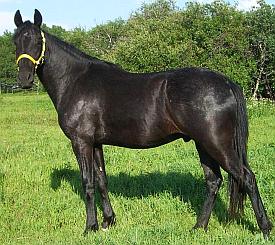 Tennuvian horses are a cross between Tennessee Walking
Horses and Peruvian Pasos. Although there is a strong chance these two breeds
have been crossed before, the Tennuvian name was officially coined by Paula
Bosner of Colorado.
Tennuvian horses are a cross between Tennessee Walking
Horses and Peruvian Pasos. Although there is a strong chance these two breeds
have been crossed before, the Tennuvian name was officially coined by Paula
Bosner of Colorado.
Paule purchased one of these crosses and immediately fell in love with the animal, so much so that she sold off her quarter horses and bought a Peruvian stallion for breeding. Tennuvian horses have smooth gaits much like Tennessee Walking Horses; however they are smaller. They have a head much like a Peruvian Paso Fin small and refined. They are able to gait for long distances, have good endurance, good hoof, comes in all colors and is comfortable for the rider. The temperam ... | ||
 | ||
| ||
 Tersk, also known as Tersky, horses were founded in Ukraine.
They are primarily used for racing, competition, endurance training, and
sports. They are considered to be calm and very hardy.
Tersk, also known as Tersky, horses were founded in Ukraine.
They are primarily used for racing, competition, endurance training, and
sports. They are considered to be calm and very hardy.
Tersk horses were developed sometime during the nineteenth century as military mounts. That time they were refered to as Streletsky horses. By the time the twentieth century they suffered a massive decrease in popularity. There were two variations that survived refered to as Tsilindr and Tsenitel. In the early nineteen hundreds, around 1925, a brand new breed had formed. They were noted to be found in the Tersk Stud and that became the new name from there on. Today they can be found in Georgia, Turkey, Armenia, around the Russian ... | ||
 | ||
| ||
 Thoroughbreds are most commonly associated with horse racing
but they excel in many area. They originated in Britain starting in the late 17th century for speed and racing
with the influence of Arabian bloodlines. Today, they continue to dominate the racing
industry but Thoroughbreds also excel in eventing, show jumping, and dressage. They
come in a variety of solid colors like bay, chestnut, and black and, on very rare
occasions, palomino and pinto. On average, a Thoroughbred stands between 15 and
17 hands high (60” to 68”at the shoulder) and weighs from 1,000 to 1,200 pounds
with a lean build.
Thoroughbreds are most commonly associated with horse racing
but they excel in many area. They originated in Britain starting in the late 17th century for speed and racing
with the influence of Arabian bloodlines. Today, they continue to dominate the racing
industry but Thoroughbreds also excel in eventing, show jumping, and dressage. They
come in a variety of solid colors like bay, chestnut, and black and, on very rare
occasions, palomino and pinto. On average, a Thoroughbred stands between 15 and
17 hands high (60” to 68”at the shoulder) and weighs from 1,000 to 1,200 pounds
with a lean build.There have literally been hundreds of famous thoughbreds including:
| ||
 | ||
| ||
 Timor Ponies evolved on the Indonesian island of Timor, probably
from Indian breeds that were imported to the island. On Timor these ponies are mainly
used for cattle work, as well as for riding, driving, and light farm work.
Timor Ponies evolved on the Indonesian island of Timor, probably
from Indian breeds that were imported to the island. On Timor these ponies are mainly
used for cattle work, as well as for riding, driving, and light farm work.Timor Ponies are described as being strong, frugal, and agile, and are lovely natured and intelligent. They have a narrow frame, short back, muscular neck, prominent withers, and a sloping croup. Their shoulders are straight, and the legs and feet are strong. Timor ponies usually stand 10-12 hands high (between about one and 1.2 meters), and are usually brown, black or bay, but may also be grey. They sometimes have a light colored mane and tail. During the first half of the nineteenth centu ... | ||
 | ||
| ||
 Please see Gypsy Vanner Horses.
Please see Gypsy Vanner Horses.
| ||
 | ||
| ||
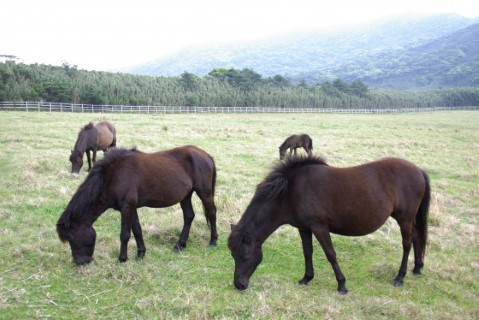 Tokara Horses (Tokara uma ) are believed to be indigenous to Japan and are currently raised in the Tokara Islands, a chain of Island in Kagoshima. They are known for their tolerance to heat and have been used for agriculture, conveyance, and sugar cane squeezing.
Tokara Horses (Tokara uma ) are believed to be indigenous to Japan and are currently raised in the Tokara Islands, a chain of Island in Kagoshima. They are known for their tolerance to heat and have been used for agriculture, conveyance, and sugar cane squeezing.There are now 107 Tokara ponies, some of them on display at Hirakawa Zoo in Kagoshima. Source: Japanese Horse Breeds ( www.lingualift.com/blog/japanese-horse-breeds/rn ).
| ||
 | ||
| ||
 The Tolfetano horse is
originally from central Italy, and in particular from Monti della Tolfa, the area
between Rome and Viterbo which was once Etruscan.
The Tolfetano horse is
originally from central Italy, and in particular from Monti della Tolfa, the area
between Rome and Viterbo which was once Etruscan.The breed was already well-known at the time of the Etruscans. It is very hardy, and still bred in the wild. This breed is strong, well-built and tough. Once used as a pack-horse and for rounding up cattle, it is now normally used for riding in the countryside, or raised for meat on pasturage unsuitable for cattle. Source: Agraria.org | ||
 | ||
| ||
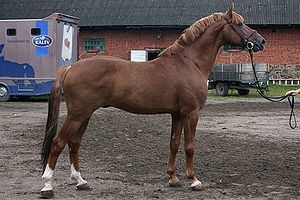 Tori, or Tori Hobune, horses were developed at the Tori stud
in Estonia from 1890 to 1950. They were developed by crossing native Estonian
mares with European half bred stallions. They were mainly founded by a stallion
named Hetman, whose sire was Stewart, a crossbreed of a Norfolk Trotter and an
Anglo-Norman mare. The Tori breed was formed by breeding Hetman and his sons.
Thus, a valuable breeding nucleus rapidly formed, that slowed as signs of
inbreeding depression were found in the 1930''s. This deteriorated performance
and robustness. To eliminate this inbreeding depression, Toris were crossed
with Breton Post-horse stallions, and as a result, the massive type of Tori
became widespread while the quality of the gaits declined. T
...
Tori, or Tori Hobune, horses were developed at the Tori stud
in Estonia from 1890 to 1950. They were developed by crossing native Estonian
mares with European half bred stallions. They were mainly founded by a stallion
named Hetman, whose sire was Stewart, a crossbreed of a Norfolk Trotter and an
Anglo-Norman mare. The Tori breed was formed by breeding Hetman and his sons.
Thus, a valuable breeding nucleus rapidly formed, that slowed as signs of
inbreeding depression were found in the 1930''s. This deteriorated performance
and robustness. To eliminate this inbreeding depression, Toris were crossed
with Breton Post-horse stallions, and as a result, the massive type of Tori
became widespread while the quality of the gaits declined. T
...
| ||
 | ||
| ||
 Trait du Nords are heavy draft horses developed and bred in
France. Trait du Nord’s ancestry includes bloodlines from the Ardennes,
Belgian, and Boulonnais breeds, and are sometimes incorrectly referred to as a
branch of Ardennais horses. They became recognized as a separate breed of their
own at the beginning of the 20th century, and the studbook for the Trait du
Nord was established in 1919. Today, although they are still bred in the area
around Lille, in the Pas-de-Calais, the Aisne, the Somme, and the
Seine-et-Marne departments, they are declining in numbers.
Trait du Nords are heavy draft horses developed and bred in
France. Trait du Nord’s ancestry includes bloodlines from the Ardennes,
Belgian, and Boulonnais breeds, and are sometimes incorrectly referred to as a
branch of Ardennais horses. They became recognized as a separate breed of their
own at the beginning of the 20th century, and the studbook for the Trait du
Nord was established in 1919. Today, although they are still bred in the area
around Lille, in the Pas-de-Calais, the Aisne, the Somme, and the
Seine-et-Marne departments, they are declining in numbers.
They have a reputation for great pulling power and hardiness, as well a calm disposition. They are considered well-suited to draft and farm work in hilly and r ... | ||
 | ||
| ||
 Trakehner Horses (official name: "The East Prussian
Warmblood Horse of Trakehner Origin" ) are the oldest warmblood breed in
the world, with a history spanning amost 300 years. They originated from a
small horse, bred in East Prussia , known as the "Schwaike". The
Schwaike was known for his versatility and endurance. When this breed was
crossed with imported English thoroughbred and Arabian stallions, the resulting
horse was named after the main stud it came from: Trakehnen. They originally
were bred as calvary mounts.
Trakehner Horses (official name: "The East Prussian
Warmblood Horse of Trakehner Origin" ) are the oldest warmblood breed in
the world, with a history spanning amost 300 years. They originated from a
small horse, bred in East Prussia , known as the "Schwaike". The
Schwaike was known for his versatility and endurance. When this breed was
crossed with imported English thoroughbred and Arabian stallions, the resulting
horse was named after the main stud it came from: Trakehnen. They originally
were bred as calvary mounts.
In the early 18th century, King Friedrich Wilhelm I realized that a new type of cavalry mount was needed as war tactics had changed and demanded a faster, lighter horse that also posessed power and e ... | ||
 | ||
| ||
 Turk (also known as Turkmene, Turkmen, or Turkmenian) horses
are an ancient Turkoman breed. They are thought to be extinct in its pure form.
Horses bred in Turkmenistan are still called by the same name; however most
likely the purest descendants of this ancient breed are the Barb, Akhal-Teke,
and Iomud horses. Of the three, Akhal-Teke breeding has been kept the purest
and probably the closest to actual Turkoman blood.
Turk (also known as Turkmene, Turkmen, or Turkmenian) horses
are an ancient Turkoman breed. They are thought to be extinct in its pure form.
Horses bred in Turkmenistan are still called by the same name; however most
likely the purest descendants of this ancient breed are the Barb, Akhal-Teke,
and Iomud horses. Of the three, Akhal-Teke breeding has been kept the purest
and probably the closest to actual Turkoman blood. The original Turk horses was a robust animal built for carrying heavily armed soldiers into battle – this build remains in the breed of today. On average they were 15 – 16 hands high. Their head was well proportioned with a straight profile. Their neck was long and lean. Their back was long an ... | ||
 |
Horses for Sale | ||||
View Horses for Sale At www.livestockofamerica.com/Horses/ |
 www.livestockofCanada.com/Horses/ |
|||